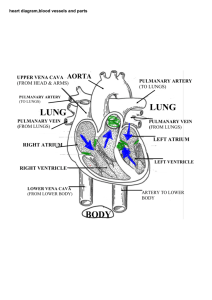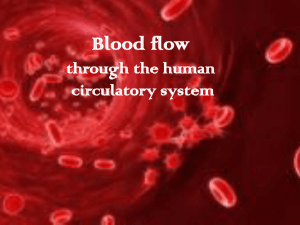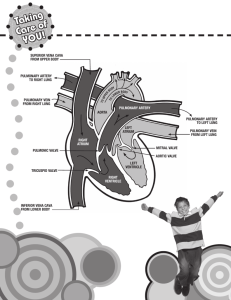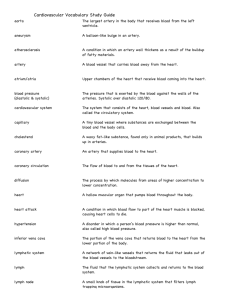The Circulatory System and Blood
advertisement
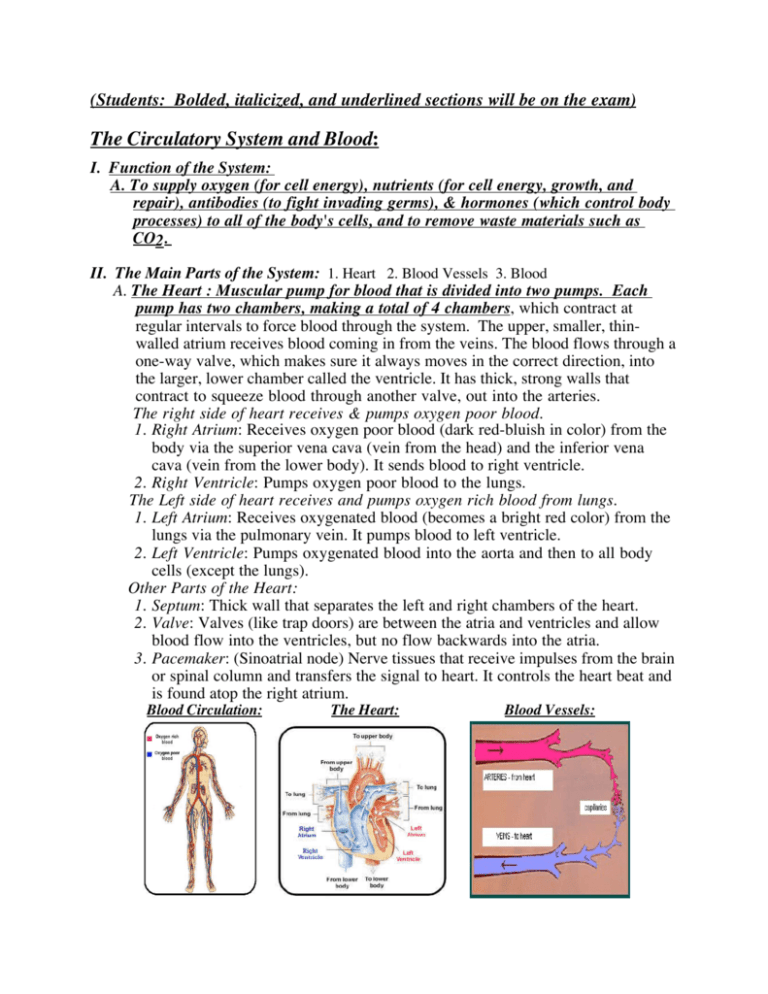
(Students: Bolded, italicized, and underlined sections will be on the exam) The Circulatory System and Blood: I. Function of the System: A. To supply oxygen (for cell energy), nutrients (for cell energy, growth, and repair), antibodies (to fight invading germs), & hormones (which control body processes) to all of the body's cells, and to remove waste materials such as CO2 . II. The Main Parts of the System: 1. Heart 2. Blood Vessels 3. Blood A. The Heart : Muscular pump for blood that is divided into two pumps. Each pump has two chambers, making a total of 4 chambers, which contract at regular intervals to force blood through the system. The upper, smaller, thinwalled atrium receives blood coming in from the veins. The blood flows through a one-way valve, which makes sure it always moves in the correct direction, into the larger, lower chamber called the ventricle. It has thick, strong walls that contract to squeeze blood through another valve, out into the arteries. The right side of heart receives & pumps oxygen poor blood. 1. Right Atrium: Receives oxygen poor blood (dark red-bluish in color) from the body via the superior vena cava (vein from the head) and the inferior vena cava (vein from the lower body). It sends blood to right ventricle. 2. Right Ventricle: Pumps oxygen poor blood to the lungs. The Left side of heart receives and pumps oxygen rich blood from lungs. 1. Left Atrium: Receives oxygenated blood (becomes a bright red color) from the lungs via the pulmonary vein. It pumps blood to left ventricle. 2. Left Ventricle: Pumps oxygenated blood into the aorta and then to all body cells (except the lungs). Other Parts of the Heart: 1. Septum: Thick wall that separates the left and right chambers of the heart. 2. Valve: Valves (like trap doors) are between the atria and ventricles and allow blood flow into the ventricles, but no flow backwards into the atria. 3. Pacemaker: (Sinoatrial node) Nerve tissues that receive impulses from the brain or spinal column and transfers the signal to heart. It controls the heart beat and is found atop the right atrium. Blood Circulation: The Heart: Blood Vessels: B. Types of Blood Vessels: 1. Artery: Transports blood away from the heart to all body tissues. Must be thick, muscular & elastic to withstand pressure from heartbeat. 2. Arteriole: Much smaller, very muscular.!Major role in control of blood pressure. 3. Capillary: Thin blood vessels in the tissues (about one red blood cell wide) through which oxygen & nutrients diffuse to the cells, and wastes & CO2 diffuse into the blood. Found between all arteries & veins. 4. Vein: Blood vessels carrying blood to the heart from body tissues or organs. Are thin-walled as blood pressure is low. 5. Venule: Same size as arterioles, less muscular.!Carry blood towards the heart.! Specific Blood Vessels: 1. Aorta: The largest artery in the body. It is a large, thick muscled artery through which oxygenated blood leaves the heart (from left ventricle) for the body tissues. 2. Vena Cava (superior & inferior): Large veins collecting oxygen poor blood from smaller veins in body. Superior v.c. brings blood from upper body, inferior v.c. brings blood from the lower body. 3. Pulmonary Artery: Artery transporting oxygen poor blood from right ventricle to lungs. 4. Pulmonary Vein: Vein transporting oxygen rich blood from lungs to left atrium. C. Blood: The Average adult has about 5 to 6 liters of blood (about 1.5 gallons). Functions of Blood: 1. Transportation of the following to every organ in the body: • Oxygen and Carbon Dioxide • Nutrients and metabolic waste products • Hormones.! 2. Protection against invading organisms (bacteria and viruses) 3. Distribution of body heat Red Blood Cells: The Major Parts of Blood: 1. Plasma: • The liquid part of blood that carries food to the cells and picks up wastes. • Makes up 55% of blood • Is made of 90 to 95% water • Carries red blood cells, white blood cells, nutrients, cell wastes, and proteins 2. Red Blood Cells (=Erythrocytes): • More than 99% of the cells in blood are erythrocytes.! • ‘Donut’ shaped • Contains hemoglobin which carries oxygen to the body’s cells 3. White Blood Cells (=Leukocytes; 5 total types of wbc’s): • One in 500 blood cells are white blood cells. • They destroy invading organisms such as viruses, bacteria, fungi, and parasites. • Related to the immune response are: Antibodies =Protein molecules which recognize specific chemical structures on the surface of invading organisms, and Antigens=Structures which stimulate an antibody response.! 4. Platelets: • Proteins whose function is the clotting of blood, sealing any cuts in your skin Blood Types: • Blood types are dependent on the types of proteins found in the blood (3 main proteins are A, B, or O which create four types: A, B, AB, and O) • In order for a blood transfusion to be safe, the blood types for the two people must match. • Type O can be donated to anyone, and is called the ‘universal donor’(O-) • Type AB can receive any type of blood transfusion, and is called the ‘universal recipient’ • There is also the Rh factor (+or-), which is another factor in blood typing. III. The 3 Types of Circulation: A. Pulmonary Circulation: 1. Movement of blood between heart & lungs. 2. It involves oxygenation of blood. 3. It is the pathway from right side of heart (where there is deoxygenated blood that is low in oxygen and is dark red-bluish), to lungs (where blood becomes oxygenated and turns bright red), and back to the left side of heart. 4. The blood flow: right ventricle ---> pulmonary artery ---> lungs ---> pulmonary vein ---> left atrium. B. Systemic Circulation: 1. Movement of blood between the heart and the body. 2. It is the pathway from left side of heart, to body tissue (where, in the capillaries, the nutrients and oxygen are released to the body cells, and carbon dioxide and other waste products flow into the bloodstream from the cells), and back to right side of heart. 3. The blood flow: left ventricle ---> aorta --> arteries ---> capillaries in the body tissues ---> veins ---> vena cava (superior vena cava from the head, and inferior vena cava, from the lower body) ---> right atrium. C. Cardiac Circulation: 1. It is the pathway from left side of heart, to heart muscles, to right side of heart. 2. It is involved in bypass surgery. IV. Interaction with Other Systems: The circulatory system interacts with every system, since it provides the materials necessary for life to every cell in every organ system. Some examples of systems that directly interact with the system include: • The Respiratory System: Blood gets rid of the carbon dioxide wastes and becomes oxygenated. • The Digestive System: Nutrients are absorbed into the bloodstream in the intestines. • The Urinary System: Blood is filtered of wastes in the kidneys. • The Endocrine System: Hormones from the Endocrine System travel via the bloodstream. • The Lymphatic System: Along with the white blood cells in the blood, make up the immune capability of the body that fights infection. • The Integumentary System: Blood flow near the skin helps to dissipate heat from the inner core of the body. Also, excess body salts are expelled via the skin. • V. Some Diseases and Disorders: Heart Disease: The number one killer of Americans. Affected by genetics, poor diet (high in saturated fat/LDL ‘bad’ cholesterol), cigarette smoking, alcohol use, and sedentary lifestyle (lack of exercise). Results are: • Hypertension: High blood pressure caused by the narrowing of the arteries over time, which can eventually damage the heart, kidneys, ... • Heart Attack: Blood flow to the heart is restricted due to blood vessels being ‘clogged’ with plaque (cholesterol buildup on the inside of the arteries; narrows blood flow). Results in cardiac tissue damage, ... • Stroke: Blood flow to the brain stops due to (coronary) blood vessels being ‘clogged’ with plaque. Results in brain damage, ... • Angina: Lack of oxygen to the heart usually due to the narrowing of the arteries. Results in tight chest pain, ... • Atherosclerosis/Arteriosclerosis: Hardening of the arteries due to plaque build up. Can lead to hypertension,... Blood Related Diseases and Disorders include: • Sickle Cell Anemia: Blood disorder in which the red blood cells are sickle shaped and cannot carry oxygen to the cells; also ‘clog’ in capillaries. Results in chronic fatigue and increased chance of strokes, ... • Hemophilia: A genetic, blood clotting disorder; affected person lacks protein clotting factors that allow for cuts, abrasions, etc... to clot. Results in continuous bleeding,... • Anemia: Disorder in which the victim lacks red blood cells, hemoglobin, or iron (to make hemoglobin), therefore causing the body to be ‘oxygen deficient’. Results in fatigue. Can be treated with iron pill supplements (less severe cases) and/or a bone marrow transplant (in severe cases)... • Leukemia: Cancer of the blood, whereby too many white blood cells are being created, lessening the number of red blood cells in the blood. VI. Other Facts: • The average pulse rate is about 70 beats per minute at rest. • During exercise, it can reach 150 bpm or greater. • The heart beats approximately 100,000 times per day. • Your heart is about the size of your clenched fist. • The human circulatory system is a closed system, however, some animals, such as a clam, have an open circulatory system in which blood is pumped into the body cavity, and not through closed blood vessels. • The cells of the heart are ‘self-excitable’, which means that they do not require a nerve impulse from the nervous system to contract. The contraction begins in the sinoatrial node, aka the pacemaker. • Systolic blood pressure occurs during heart contraction. • Diastolic blood pressure occurs during heart relaxation.
